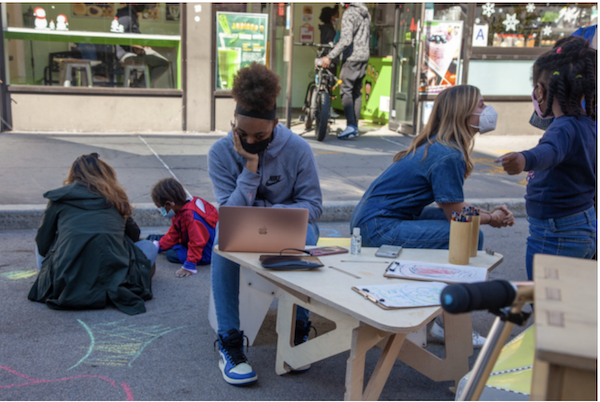
Public spaces are sometimes the only way some people can access the internet.
Given the pivotal role that high-speed internet played in allowing us to stay connected and continue functioning during the COVID-19 pandemic, it has become clear that it is a vital resource that all Americans deserve to be able to access and afford.
Unfortunately, millions of Americans are still without this necessity, putting them at a significant disadvantage in virtually all facets of modern life.
While a small number of Americans, particularly those in very rural areas, aren’t online because they lack access to broadband infrastructure, there are two prime causes fueling this digital divide, the first being the affordability gap, meaning people who can’t afford the cost of an internet subscription, and the second being the adoption gap, or people who aren’t online because they lack the necessary digital skills or fail to see its value.
The National Urban League’s digital equity report highlights the primary role that these two factors play in causing the digital divide, as it notes that the segment of Americans who aren’t online because they lack the skills or means to connect is three times larger than those who aren’t online because they lack access to broadband infrastructure.
This dynamic holds true for nearly everyone in our state — just 2% of Ohioans lack access to broadband infrastructure under the FEC’s benchmark, but nearly 15% do not have an internet subscription. And much of Ohio is already fully covered. In my home county, for example, 100% of Summit County has access to three or more internet service providers, but far too many people face cost, skills and other barriers.
For the small percentage of Ohio citizens who live in places without broadband availability, it will be pivotal for local officials and providers to collaborate to expand coverage to all areas that are still without access. But for the vast majority of Ohioans that are not online we must address affordability and adoption issues head-on to get them connected as quickly as possible.
The good news is, we have the tools to do just that thanks to the recently passed bipartisan Infrastructure Investment and Jobs Act, which allocates significant funding to address these issues.
The new infrastructure law includes a $14.2 billion investment to establish the Affordable Connectivity Program (ACP), a groundbreaking new initiative that offers up to a $30 monthly benefit for families at 200% of the poverty line and allows them to afford an internet subscription at a drastically reduced rate.
Just the other day, President Biden announced a deal with providers to lower the costs and increase speeds of entry-level broadband plans which, when combined with the ACP will make internet free for over 3.1 million (28%) of Ohioans. For the affordability gap to be closed, we must amplify the program.
The Infrastructure Investment and Jobs Act also provides tools to address the adoption gap through its inclusion of $2.75 billion toward grant programs geared toward digital literacy initiatives and other resources.
Specifically, these programs will assist our nation’s most vulnerable and impacted communities regarding the adoption gap — primarily older, low-income and non-native English-speaking groups — by educating them on digital skills and how to easily get connected.
In Summit County, local officials have shown a keen understanding of the need to resolve the affordability and adoption gap, which has been exemplified by their implementation of “WiFi Zones,” which, through a partnership between the county, the City of Akron, and the Ohio Capital Impact Corporation seeks to bridge the digital divide WiFi for low-income residents living in Akron Metropolitan Housing Authority Public Housing. This can serve as a model for other communities across Ohio.
However, there is much more work to be done given that only about 17% of eligible Ohioans are currently enrolled in the new Affordable Connectivity Program. States like New York and Michigan have already taken advantage of the ACP and are running TV ads urging residents. Now it’s time for Ohio leaders to find ways to promote the program. It’s already funded and the transformative impact it can have is at our fingertips.
By increasing enrollment and awareness of these two federally funded initiatives through the Infrastructure Investment and Jobs Act we will make significant strides in closing Ohio’s digital divide.
However, some in cities like Akron and Columbus are mistakenly calling for an alternative option — a government-owned, maintained and operated broadband network that would strip significant funding from other problems that need addressing, like the drug epidemic and the need for hard infrastructure, while also doing little to address the actual root causes of the divide.
This proposal seeks a long-term and ineffective solution to a problem that needs to be addressed now. Students without the necessary digital resources to learn don’t have years to wait, especially when the tools to close the divide are already in our grasp.
We must amplify the federally funded solutions we already have, rather than get distracted by this long-term fool’s gold approach.
• • •• • •
Ophelia Averitt is an Executive Committee Member of the Ohio Conference of the NAACP and the former president of the Akron NAACP.
This story is provided by Ohio Capital Journal, a part of States Newsroom, a national 501 (c)(3) nonprofit. See the original story here.














